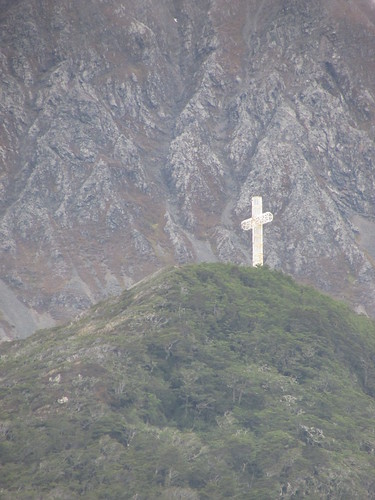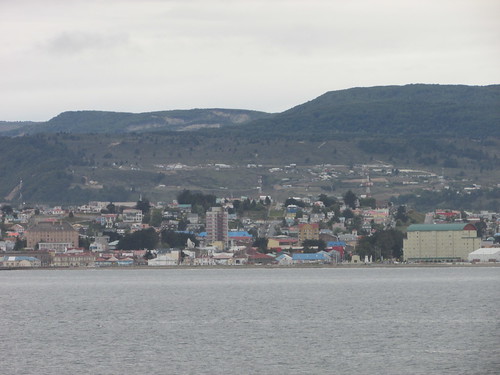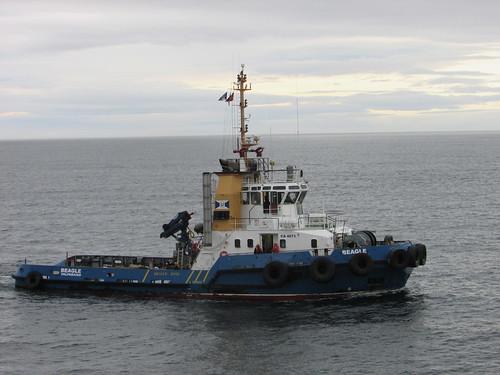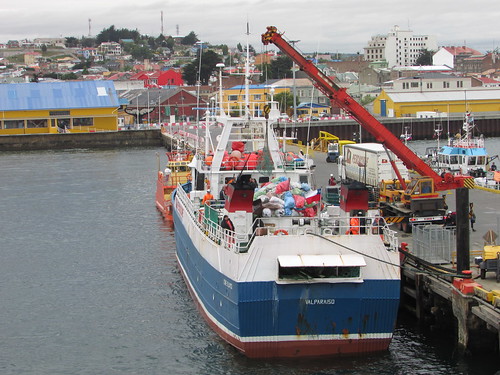At some time during the early hours of Tuesday, we left sheltered waters for a time and the wave action became more pronounced. It didn’t greatly disturb me but other guests reported minor accidents with loose items sliding around. We were cruising south-east in the Strait of Magellan, a channel with steep, grassed sides and some exposed rock. Traces of snow remained on the peaks and mist hung on the mountain tops. The weather was overcast but surprisingly warm in locations sheltered from the wind. After a leisurely breakfast, I attended an informative lecture ‘Antarctic Biodiversity: An Overview’ by Hans Peter.
Before long, lunch was upon us followed by a choice of lectures in the theatre during the afternoon. I missed the lecture on Vulcanology by Steffan since it conflicted with our transit past Cape Froward where the Strait of Magellan turns northwards to reach Punta Arenas.

Strait of Magellan: Cape Froward.
Strictly speaking, Cape Froward is the southernmost point on the South American continent since Tierra del Fuego on the opposite side of the Strait of Magellan is an island and the better-known Cape Horn is on a further island, south of Tierra de Fuego.

Strait of Magellan: Passing Cape Froward.
Favourable winds meant that we were able to dock in Punta Arenas earlier than anticipated at around 20:30 on Tuesday evening. At the Recap and Briefing, the Expedition Leader announced that it should be possible for passengers to go ashore to explore late evening on Tuesday, in addition to the planned excursion on the following day. I decided to skip dinner at 19:30, in order to be able to watch the docking at the jetty and then be ready to go ashore.
Punta Arenas revealed itself as a large town which had originally developed along the shore but now extended into the low hills on the landward side.

Arriving at Punta Arenas.
A single, straight jetty extended into the sea and, as we approached the quay, two modern, powerful tugs appeared and ‘shadowed’ us in. As I watched the ‘Pelicano II’, the tug just astern of us on the port side, three dolphins breached the water in synchronism in between our ship and the tug before disappearing again, repeating this performance two or three times, each time nearer the bow of the tug. After a short pause, the dolphins repeated their leaping further forward on the port side before moving to the bow of our ship and delighting a new audience.
Apparently, the dolphins were not alone in wanting to display their prowess in the water. The second tug accompanying us was ‘Beagle’, matching our speed and keeping station on the port side near our bow.

Arriving at Punta Arenas: Tug 'Beagle'.
Then, for no obvious reason, the manoeuvrable 'Beagle' turned through 180 degrees and matched our speed travelling astern! Once having proved the point, ‘Beagle’ turned again and once again matched our speed going ahead. I indicated my appreciation of this manoeuvre by a very small nod of my head, which was rewarded by a broad smile from the deckhand on the ‘Beagle’, after which we exchanged friendly waves.
Using the control panel on the starboard bridge wing, our Captain gently eased ‘Silver Explorer against the quay watched by the various shore parties waiting to receive the mooring lines from the ship. One of our two Chilean Pilots who had travelled with us from Valparaiso was also on the bridge wing, using a handportable radio. Within a few minutes, our ship was secured and the gangway was set up between Deck 5 and the quayside.

View of jetty and Punta Arenas from the deck of 'Silver Explorer'.
Once the ship had been cleared by Chilean Customs, passengers were allowed ashore. The credit-card sized room key was also used to tally guest movements on and off the ship using a laptop computer, both via the gangway or Zodiac. We were allowed to walk the length of the jetty and were then waved through the entrance gates by port security staff.
The town square (Plaza de Armas) was only a few hundred yards away and I’d determined to explore at least that far. A small group of passengers disembarked at the same time and fanned out in various directions. Punta Arenas developed to support Atlantic – Pacific shipping via the Strait of Magellan but the opening of the Panama Canal, of course, damaged that trade. There was a short-lived Gold Rush but sheep farming provided more enduring traffic. The population is now around 150,000 and the town is clean and pleasant, a mixture of modern and more classical French and Spanish styles of architecture. Having reached the town square, I decided to explore a little further and I reached the building of the Maggiorino Borgatello Museum before deciding to return to the ship by a slightly different route. On the way back, I started to pass many more guests who had decided to take dinner on the ship before venturing out.
Back in my cabin, I had a club sandwich, chocolate mousse and English breakfast tea from room service, after which I retired to bed.
Related Posts
Next post describing this trip: Visiting Punta Arenas.
All posts describing this trip: Chilean Fjords.
My pictures
Where necessary, clicking on an image above will display an 'uncropped' view or, alternately, my pictures from this (and earlier) trips may be selected, viewed or downloaded, in various sizes, from the albums listed:-
Aboard 'Silver Explorer'.
Strait of Magellan: Cape Froward.
Arriving at Punta Arenas.
All my pictures of Chile can be found in the collection Chile.
[Date of events corrected: 24-Nov-2016. Links to pictures added, pictures added: 25-Jan-2017]
